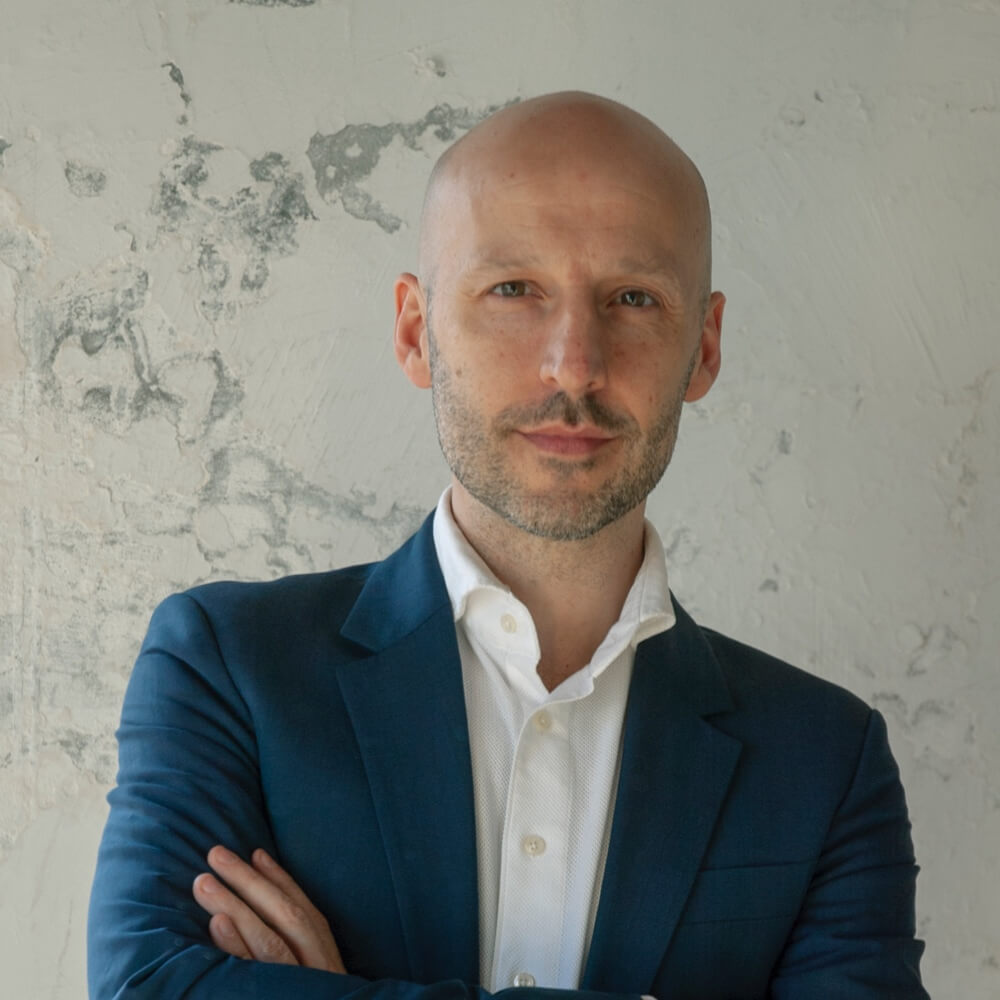Aldo Bakker
Glenn Adamson interviews the Dutch designer in the run up to his latest New York show.
EXHIBITION TITLES DON’T get any more apt than ‘Slow Motion’, a presentation by the leading Dutch designer Aldo Bakker at Carpenters Workshop Gallery, New York City. The show, which runs from 25th April to 22nd June, includes a diverse range of his precisely calibrated sculptural forms – each the result of long consideration and research into materials and optimisation of form.
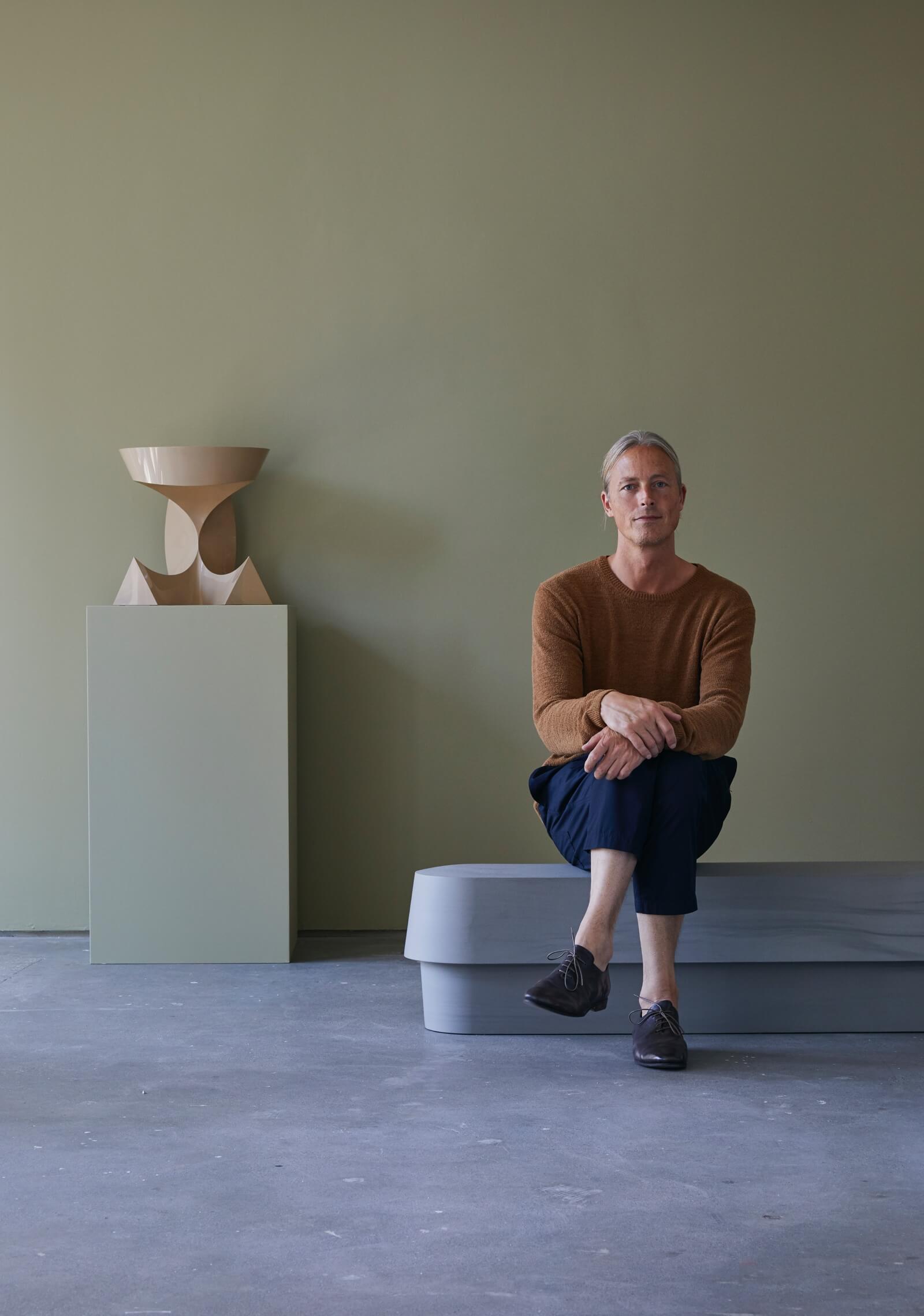
Aldo Bakker with ‘Sitting Table (urushi)’, 2019
COURTESY: Carpenters Workshop Gallery
GA: The large-scale works in Slow Motion are made from two primary materials, urushi lacquer and carved stone. Could you tell us about those choices, and how you see the relationship between the two?
AB: We had already been working with urushi for some years; it has an important place in my oeuvre. So whenever I get the opportunity to work with it I do, because I find it so beautiful. The reason for the stone partly comes from a desire for balance. The urushi works take half a year to a year to make, and so are very expensive, and also vulnerable. The stone works are faster – they take about two weeks to carve.
GA: When you say vulnerable, you mean that the glossy surface of the lacquer can be scratched?
AB: When the surface is still fresh – as it is now, when the pieces have just been completed – it can be scratched. But it becomes much harder over time. For some works, we have used a more durable technique called ishimeji, in which you dry the lacquer on a glass pane, remove it, pulverise it, and sprinkle it on a painted surface. You can compare the texture with cast iron. This was the first time we’d used this technique; it was the specific wish of the gallery to develop a surface that was less vulnerable.

Aldo Bakker, ‘Slow Motion’ exhibition, Carpenters Workshop Gallery, New York
COURTESY: Carpenters Workshop Gallery
GA: It’s interesting that the urushi gets harder over time – a living material.
AB: It is. It’s 100% natural, and what is also beautiful is that the lacquer turns more vivid over time. I believe it’s because the translucent brownish colour of the lacquer becomes gradually lighter, so the pigments shine through more.
GA: The broad colour palette of your urushi is very unusual.
AB: They are not traditional colours at all. But the objects define the colour that suits them. I just follow my feeling and they come in that way, it’s a pure instinctive process. Light colours are difficult to achieve, because the urushi is a translucent brown resin. ‘Sitting Table’ is the whitest you can get, like a coffee cream colour.

Aldo Bakker, ‘Sitting Table (urushi)’, 2019
COURTESY: Carpenters Workshop Gallery
GA: Is it difficult to photograph them?
AB: Very. Perhaps you have read this booklet In Praise of Shadows [by Jun’ichirō Tanizaki]? He says the best conditions for urushi are natural daylight and candlelight. And that is very true. When I had my retrospective at MUDAC [The Museum of Design and Applied Arts] in Lausanne, we darkened one room during the opening, and put candles in the space. It was a little bit romantic. And we stayed for the longest time in that room.
GA: Do you have the urushi made in the Netherlands?
AB: Yes, they are made by Sergej and Marina Kirilov of Studio Lacquer Decor in Arnhem. They trained with Mariko Nishide, who made my first objects – she was Japanese, and was trained in Japan. Sergej has won an award in Japan for his urushi work, which is really amazing because they don’t accept foreigners very readily in traditional crafts.
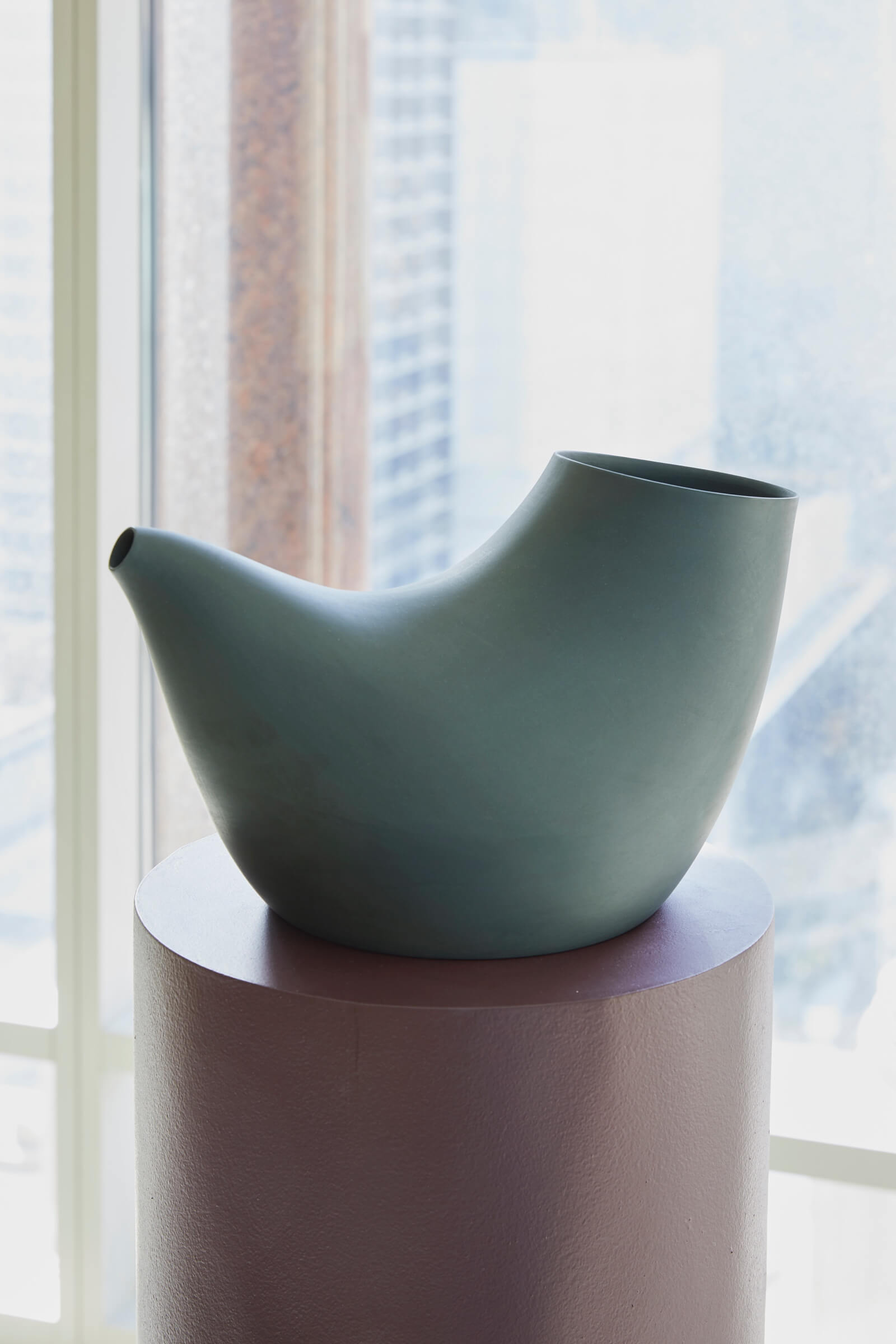
Aldo Bakker, ‘Pipe’, 2015
COURTESY: Carpenters Workshop Gallery
GA: And did you also study in Japan?
AB: I visited many studios, to see the different ways of applying urushi. Did you know there are only a few urushi forests in Japan, which are man-made? There are almost no urushi trees left – they’ve all been used. The trees need to age 10 to 15 years before you can extract the sap. It’s beautiful to see them collect it, but once they take the sap the tree dies, and the whole process has to start again. We do make use of Chinese urushi, which is less expensive, but for the top layers we use only the Japanese, as it is more refined.
GA: You have an outside view, as a Dutch designer taking an East Asian craft and making it your own.
AB: I remember when I was younger, my enthusiasm for the material was not received that willingly in Japan. It’s something you see in many crafts – there are strange borders everywhere. In my case, I take the time to establish an objective feeling toward the material, tools and everything that is needed. And then those borders aren’t there.
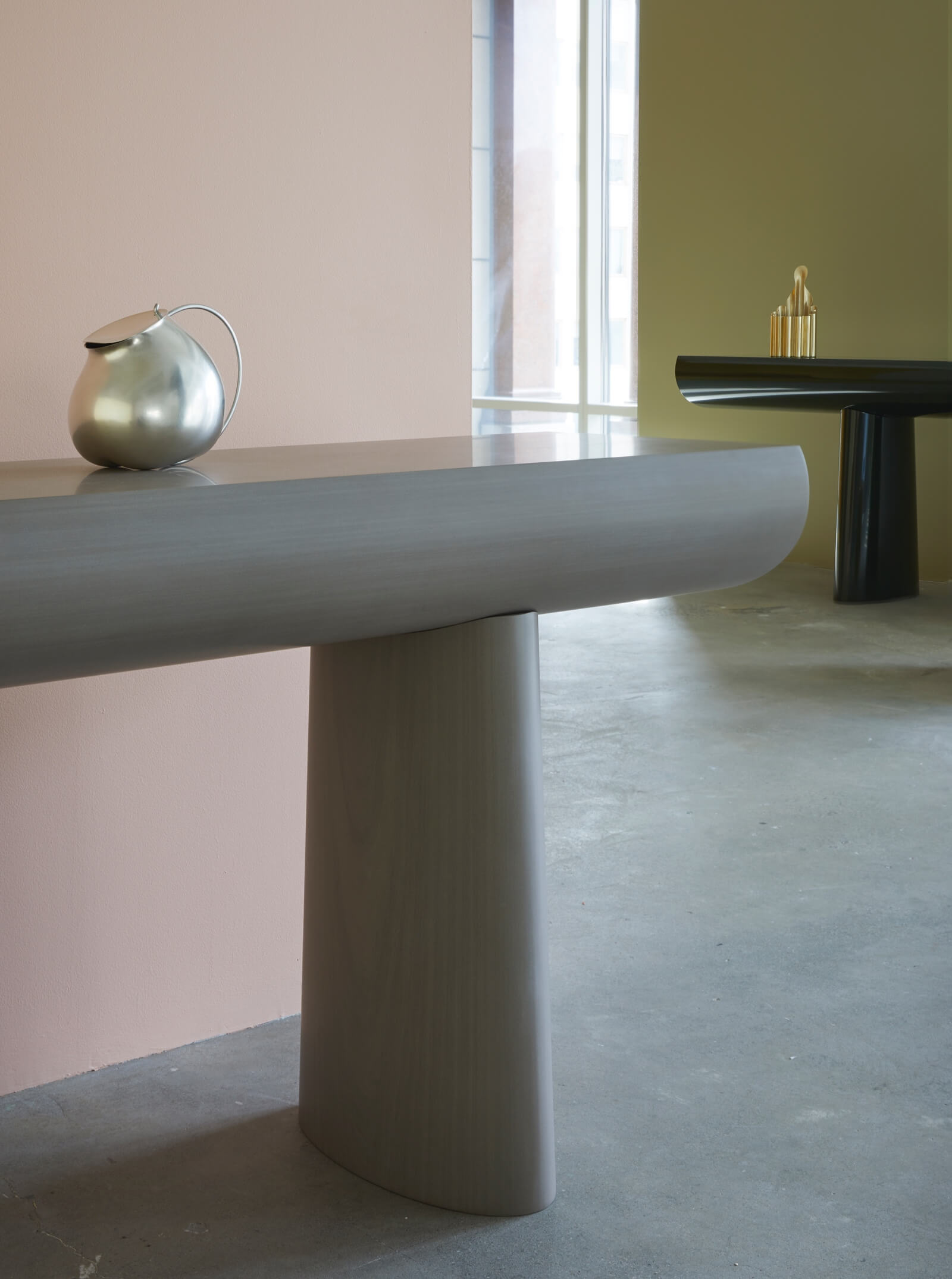
Aldo Bakker, ‘Console (stone)’, 2019 and ‘Fat One’, 2015 (foreground); ‘Console (urushi)’, 2019 and ‘Newell’, 2019 (background)
COURTESY: Carpenters Workshop Gallery
GA: Let’s return to the juxtaposition between the urushi and the stone. My impression is that in lacquer objects the energy seems flows to the surface, up to the hard carapace. Whereas the stone works seem more introverted, as if they are drawing energy into their core.
AB: More or less, yes. With the urushi, you can manipulate it so that you don’t know even what it is anymore …
GA: Almost artificial, although it is completely natural.
AB: … right. Whereas the stone is the opposite, because you always need to deal with the direction, the ‘drawing’ of the stone, and that I find difficult. My control is complete with the urushi, while with the stone it’s much more of a dialogue; I have to react. If the piece is carved from one solid block, which angle are you going to take? Sometimes the stone has one direction and the piece has another. That’s one reason why most of the stones I have chosen are dense and monolithic, not too expressive. Because my objects are expressive already.
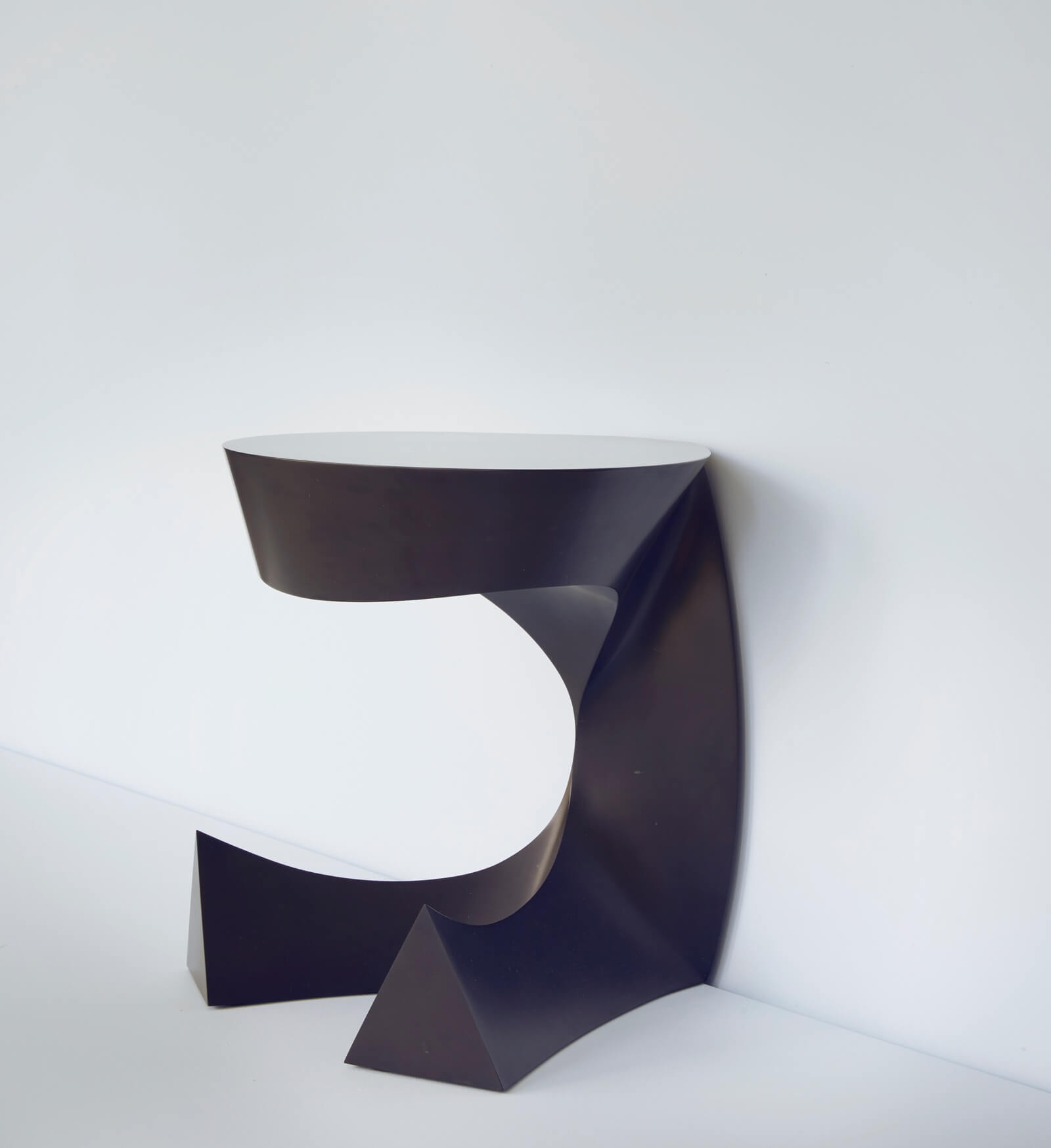
Aldo Bakker, ‘Sitting Table (stone)’, 2019
COURTESY: Carpenters Workshop Gallery
GA: Were you present while the carving was happening?
AB: No, though I have seen a lot of videos and photos, and we’ve been there a couple of times to talk through the works. We have this fantastic relationship with Testi, in Valpolicella, and Pierluigi, the director of the company. I have such admiration for what they have achieved. Every piece is made by a robot, with around one millimeter of extra material left on every surface. Then the piece is finished off by hand – the machine cannot interpret the hard and soft parts, the directionality.
GA: A long journey to arrive at the surface.
AB: Yes. I love to work with CNC, that’s again about control – we direct everything from here, I know it will come out just as I thought of it.
GA: You have some forms in this exhibition executed both in stone and lacquer, including ‘Four Parts’ – which I guess is actually made in four parts. It could suggest lips, or the bottom that’s sitting on it, or upholstered furniture – like the folded arm of an easy chair.
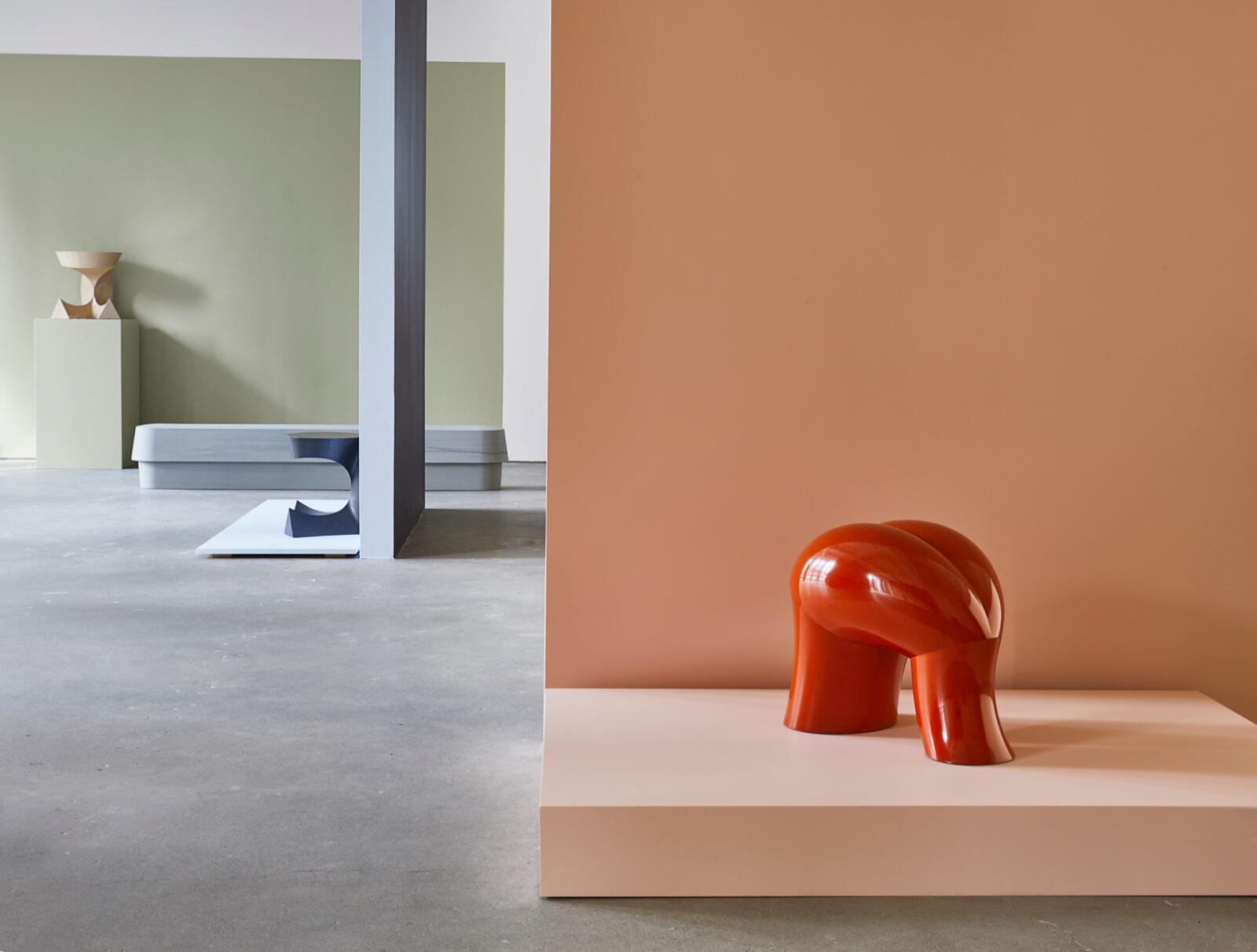
Aldo Bakker, ‘4prts (urushi)’, 2019 (foreground); ‘ ‘Sitting Table (stone)’, 2019 and ‘Long Lasting’, 2017 (midground); ‘Sitting Table (urushi)’, 2019 (background)
COURTESY: Carpenters Workshop Gallery
AB: For the stone, we made a version with internal construction that fits together like a puzzle, just like ‘Three Pair’. But we decided eventually to make it from one solid piece. It is related to my ‘Tonus’ works – if you look at that oeuvre, you see the same movement, the same upside-down U shape. So I go from one side, up, horizontally across, and then down again. That is what I do every time, but always in a different way. I am fascinated by this form – and the deeper it sinks into my system the more interesting it gets, because I escape all the superficial things that pop into my mind at first. It’s a portal, it’s a U shape, a bridge. You can also see it as part of a circle that continues beneath the floor. But we work on these pieces so long, with every form we set up in the computer – getting a grip on the logic, the shape, the pose.
GA: And each of your objects somehow carries that process, because they seem to represent the universe of all those other possibilities. Like you are catching the form only in one of its moods, or one position. It’s like a sculpture of a person or animal that implies the whole life of that creature – you are doing something similar, but in an abstract way. There is a strong sense that it could move, that it could be slightly otherwise.
AB: There is a fixed image in my mind of what it has to be. But exactly as you say, if it is perfect, then it can be interpreted endlessly. That is a conscious wish.
GA: Can we shift the conversation to the tables, which are such a different language? They have such a directional quality – a strong sense of vector, like a train rail.
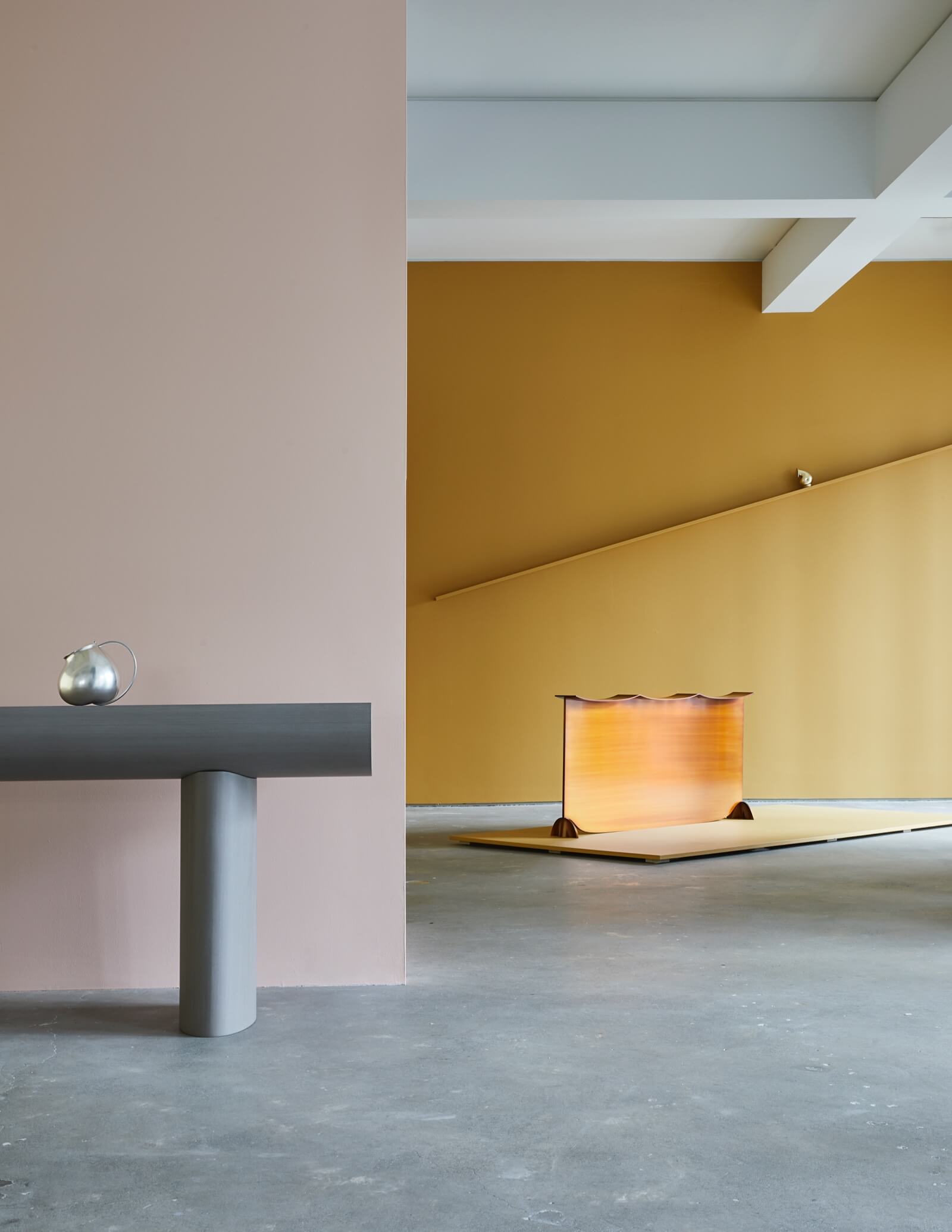
Aldo Bakker, ‘Console (stone)’, 2019 and ‘Fat One’, 2015 (left); ‘Flat Brown’, 2019 (right)
AB: ‘Console / Table’ was an existing design, in production with Karakter, a Danish company, but now produced in stone for Carpenters Workshop. You can adjust the composition yourself, though I strongly prefer the configuration where the legs are close together, and it’s not symmetrical. But I should say, I do not want to design tables or stools or chairs. I want to go one step further (or maybe backwards, I don’t know). I love tables, I love furniture, but I do not want to trap myself within a discipline. I see it happen so often around me that the discipline becomes very demanding, and the objects become restrained – exploring versions of things that we have all already accepted. For me it’s more fulfilling to come to pieces that do not depend on their function, but stand by themselves.
GA: It’s like the form exists outside of human needs, and it happens to be visiting us from another place. It swims into our world as a table, but you can imagine it leaving again.
AB: Yes, and this is very important to me. It has to do with a deeper conviction. I depend on the materials which come from our planet, and we have to be sensible about that. Something I make from stone is still stone; I don’t want to blindly impose on it. It should be a dialogue with the material. Also, it’s not about quantities: just a few is ok. This is then my personal quest. I want to do something very well so that it can last. Who knows what will happen? Maybe an epidemic. We are in a very unsure phase of history. It would be such a pity to me if someone in the far away future found one of my objects, and were only reminded of the past. I want these objects to be free, so they can live another life again.
GA: I want to ask you about another piece, the fluted vase called ‘Newel’.

Aldo Bakker, ‘Console (urushi)’, 2019; ‘Newell’, 2019; ‘Three Pair (stone)’, 2019
AB: I’m happy these fine metal works are part of the show. It’s new for Carpenters Workshop, they never do these smaller objects – though this is the biggest object I have done in this material! It’s made in an electroforming technique, very difficult to achieve. Our collaborator on this, Andre van Loon, did a tremendous job. What we do is print a shape and use the print itself to build the form. You have all the vertical lines, which you can see as a forest or stems of flowers, and gradually it goes to just one, escaping the rhythm. And it either becomes the holder for a flower, or the flower itself – so you don’t need flowers anymore.
GA: The curve just breaks the perimeter of the columnar form.
AB: Yes. So again, it’s the same story. I don’t want this to be dependent on flowers that are put into it, it has to be good as it is. Like the seating pieces – you don’t need to sit down on them, you can look and it’s enough.
GA: And finally, what about ‘Flat Brown’? It’s fascinating that it has an aluminum substrate – that gives it a latent industrial feel, which is in tension with the elegant attenuated form. Do you also see it that way?
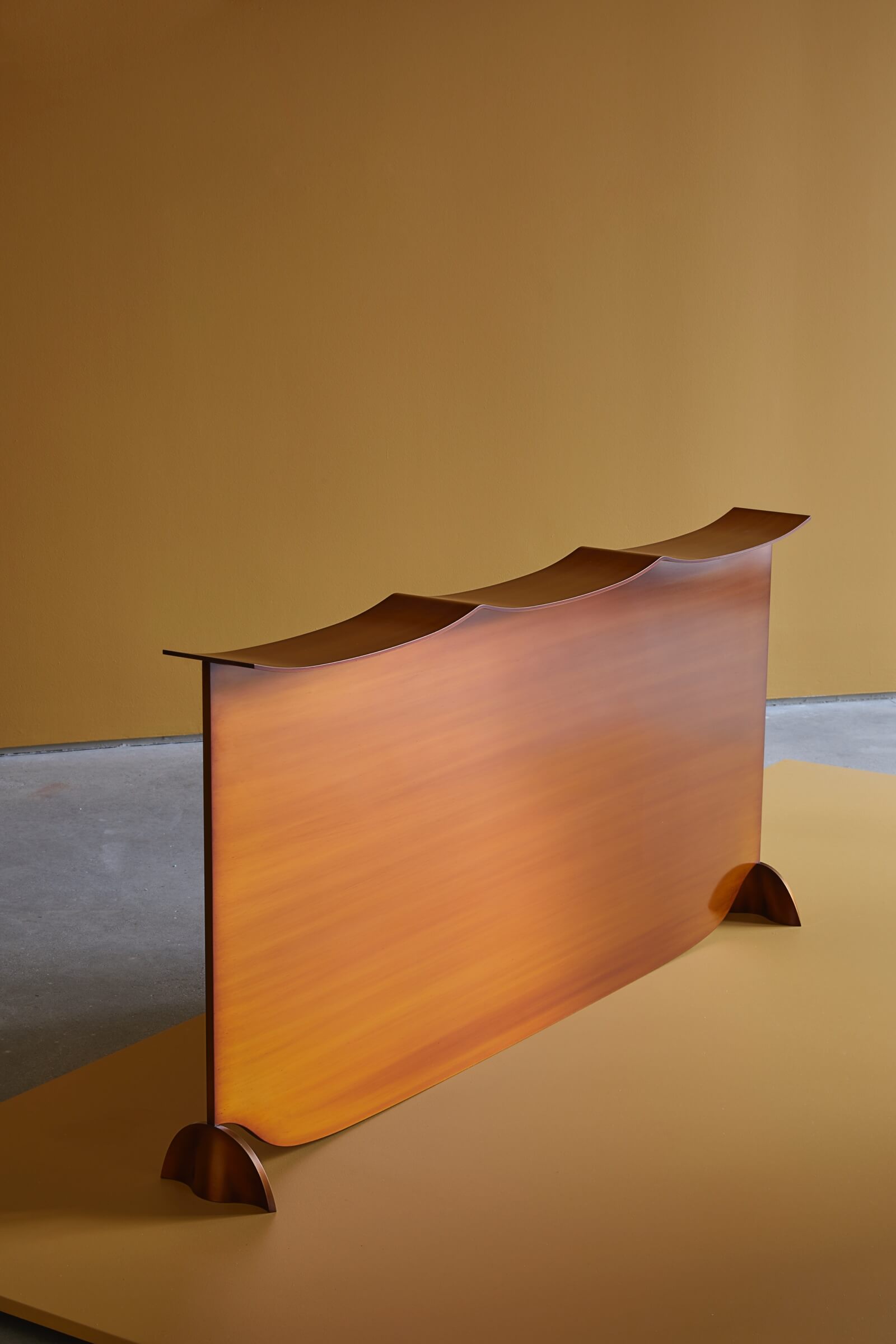
Aldo Bakker, ‘Flat Brown, 2019
COURTESY: Carpenters Workshop Gallery
AB: I think I can’t anymore. It all started with the base – the curve towards the foot – that had all my attention. That is always how it works. There are certain forms in my mind, and they intrigue me. And it’s a very dear piece to me – it came very easily, a simple sketch in my notebook. It’s really about giving a plasticity to the material which is not really there. All the elements, including the top, which is six millimeters thick – are made out of massive aluminum, CNC cut. A terrible piece to make, a nightmare. It took us years. Then it was also our wish to apply urushi to the aluminum, and this was another nightmare, really almost too much. But when you put the urushi on these aluminum parts, the edges stand out, because the lacquer doesn’t grip there. And that is very beautiful. Sergej was up in the middle of the night for a month to keep the rhythm of the urushi application, to get the tone we were looking for. But we managed it, I’m very happy and grateful.
GA: It’s extremely there, yet hardly there at all – a disappearing act.
Slow Motion runs until 22nd June at Carpenters Workshop Gallery, 693 5th Avenue, New York.
